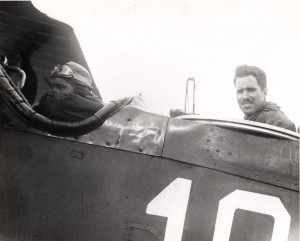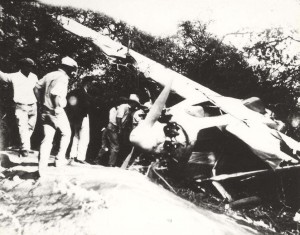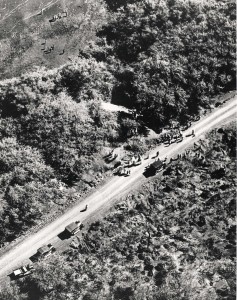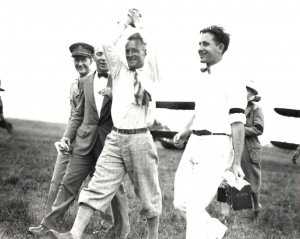Ernest Smith
 At Oakland the Army group met an exuberant ex-military pilot named Ernest Smith in 1927. An airmail flyer of late, Smith wanted the distinction of being the first to fly to Hawaii and made no attempt to dispel that impression. His drive was strong and incessant. With his navigator Captain C. H. Carter, Smith expected to go airborne momentarily and head for Hawaii in his single engine Travelair monoplane. The watching public—and Smith—began talking about a race, one between the Army and the civilians.
At Oakland the Army group met an exuberant ex-military pilot named Ernest Smith in 1927. An airmail flyer of late, Smith wanted the distinction of being the first to fly to Hawaii and made no attempt to dispel that impression. His drive was strong and incessant. With his navigator Captain C. H. Carter, Smith expected to go airborne momentarily and head for Hawaii in his single engine Travelair monoplane. The watching public—and Smith—began talking about a race, one between the Army and the civilians.
Smith was not a competitor in the Dole Air Derby, set to start two months hence. His interest was in becoming the Pacific’s Lindbergh, therefore the Army duo to him were “rivals”. There was no comparison between the two planes and crews. Years and months had gone into the Army’s flight preparations. The Army Fokker was equipped with the finest navigation equipment available, developed by its chief engineer now on the flight crew. Smith’s plane carried one simple compass and no significant modifications were made for safety. Leaping off first was his objective. The Army would not compromise safety for that questionable distinction, intent only on making the flight a success and gathering in-flight data on instruments and crew reaction.
Ernest Smith’s airplane was not quite ready to take off when the weather improved, much to his chagrin. (Army Lts. Lester Maitland and Albert Hegenberger successfully made the flight to Hawaii landing at Wheeler Field on June 29, 1927).
Back in Oakland, Ernie Smith scurried about in search of a navigator to take Carter’s place. Not expecting miracles, nonetheless the frustrated flyer hoped to find one in a matter of minutes. One of his backers, Edmund J. Moffett, assured Smith time was no longer important, and that he and his new navigator could become the first civilians to make the flight. Smith knew, that if something happened to the BIRD OF PARADISE, he could still be the first human to make the flight.
A suitable navigator was not found that day. The following morning, Smith got news of the success of Maitland and Hegenberger. Not slowing down because the “race” was over, Smith intensified his search lest some last minute entry beat him to the first civilian claim.
 A young man telephoned Bill Royal (managing Smith’s affairs) asking for the job. An appointment was arranged for the next day at the airport, for interview by Smith. His name was Emory B. Bronte. The eager applicant had taken pilot training in 1923, and was also rated a master mariner. Intrigued with the idea of flying across the ocean after Lindbergh’s conquest of the Atlantic, he had watched from a rooftop as Maitland and Hegenberger flew out the Golden Gate. “I had read about Carter bowing out of the picture,” Bronte said, “and decided to apply for the job. I wanted to make such a flight, and this was my chance.”
A young man telephoned Bill Royal (managing Smith’s affairs) asking for the job. An appointment was arranged for the next day at the airport, for interview by Smith. His name was Emory B. Bronte. The eager applicant had taken pilot training in 1923, and was also rated a master mariner. Intrigued with the idea of flying across the ocean after Lindbergh’s conquest of the Atlantic, he had watched from a rooftop as Maitland and Hegenberger flew out the Golden Gate. “I had read about Carter bowing out of the picture,” Bronte said, “and decided to apply for the job. I wanted to make such a flight, and this was my chance.”
Pleased with the attitude and enthusiasm of the young man (Smith was 12 years older than the moustached, handsome Bronte), the pilot eagerly signed Emory Bronte as navigator for the trip.
“But only on my terms” Bronte insists. “I had looked the plane over and was shocked to find it didn’t even have a radio and very little else in the way of navigational equipment. To make the trip, we needed charts, compasses, a sextant and many other items. I could see why Carter bowed out. The windshield just cinched it for him. Smith was fortunate, because had they gone out with such a lack of equipment they’d have ended up in the water. Two weeks later, we not only had a radio but it was a first class piece of apparatus. As for the compass, we had three of them installed, with the master compass calibrated so finely that a deviation was eliminated on the westerly headings (the only important headings because that’s the direction we were going to fly). The short wave radio transmitter and receiver were especially built for us by the Army Air Corps’ Lieutenant Mariner, Crissy Field’s communications officer.
Bronte’s insistence on perfection brought out a Wright engine specialist to make last minute modifications on the power plant. Kenneth Boedecker made a number of changes which, if not corrected, would have slimmed their chances of a successful flight. Riding to the airport on the morning of the flight Bronte was asked how he expected to stay awake during the long flight. The navigator foresaw no difficulty, but his concerned companion reached into the car’s first aid kit (“all automobiles carried one those days”) and handed Bronte some smelling salts, advising him to use them if he did get drowsy.
Finally, the plane was ready for flight. Smith christened it, “CITY OF OAKLAND.” On July 14th, the day of take-off Maitland and Hegenberger, who had just returned from Hawaii by ship, came to the airport to wish the flyers good luck and to pass on their experiences. Smith and Maitland discussed flying techniques, Bronte and Hegenberger the intricacies of navigating the unknown route.
Smith decided to take along four carrier pigeons to fly position messages back to California and to act as backup in the event the radio failed. Stowed securely in the cockpit, the two cages made a peculiar sight to onlookers. Bronte brought his charts, parallel rulers, dividers and other navigation aids. A rubber life boat, deflated and folded was placed between two fuel tanks. Sandwiches, coffee and milk were placed atop one gasoline tank.
Bronte had set his course for the island of Maui, rather than his Wheeler Field destination on Oahu, for two reasons. First and foremost, he intended to use the Army’s beacon connecting the stations at the Presidio of San Francisco and Paia, a village on the island of Maui, as Maitland and Hegenberger had done; also, as a safety factor for navigation, giving him the very large island of Hawaii to the left (of Maui) and Molokai and Kauai to the right, on either side of Oahu.
ON TO HAWAII
Finally all set, the flyers climbed aboard their plane. Smith started the lone engine and attempted to taxi away, but found that the overloaded Travelair refused to budge (370 gallons of fuel). Exasperated spectators were drafted to push, and the CITY OF OAKLAND responded in movement. The intrepid flyers, bumping along the dirt runway, were pleased to finally be on the way. Noisily offering good wishes were some 10,000 spectators. But then the crowd gasped. The monoplane suddenly dipped, wavered and careened into a ground loop to the right. A depression in the runway had caught one wheel on the take-off roll, much to the disgust of Smith. No damage was done and at 10:40 a.m. the airplane was forced into another attempt. This time all went well and the single-engine plane strained into the air, to the relief of the harried audience at Oakland Airport, as well as Smith and Bronte.
Oakland Airport (then known as Bay Farm Island), as with many other flying fields those days, contained a dirt runway with ruts and other surface depressions, making such take-offs common. The incident bothered the worried navigator only “because a gallon of gasoline was wasted.” Bronte unreeled the radio antenna, held beneath the plane for about 150 feet by a leaden weight attached to the end. The radio beacon was turned in and a strong signal showed they were on course.
Except for flying into a thick fog bank which obscured their view of the ocean, the flight went well for the first four hours. Then the duo joined the ranks of Maitland and Hegenberger and John Rodgers before them on this stretch of ocean route, by encountering radio trouble. Thinking the receiving set was out of order at first, the old earphones became suspect. Happily, they could still transmit messages and did so regularly on the hour throughout the flight. Damning their oversight at not including a spare headset, Bronte prepared to make use of the compass and sextant.
Two pigeons were released 200 miles out, the remaining two the following morning. (They never returned to their home lofts.) At 3:45 p.m. they transmitted an “all’s-well” message. The SS MAUNALOA received a message from the CITY OF OAKLAND at about 6:00 p.m., by which time the flyers were about 500 miles out and doing well.
Smith increased altitude to 6,000 feet that night so that Bronte could get a good view of the stars above the fog layer, for navigational purposes. At this point they were 800 miles from Oakland, flying at 120 miles per hour. Smith knew this was faster than the BIRD OF PARADISE had flown and became excited at the prospect of beating its time.
At 3:00 a.m. one of Bronte’s transmissions was picked up by the SS WILHELMINA and the Army transport KENOWIS. The signals were quite weak. However, the SS WANIWA later heard from Bronte’s transmitter with a stronger signal. Smith recalled this was as far as John Rodgers got in 1925, and then passed a note back to Bronte stating he was getting sleepy. “Reading that, I knew I was sure to stay awake,” Bronte grinned.
SOS
Now quite close to the Hawaiian Islands and a place to land, the flyers’ spirits soared only to be momentarily dampened by the cruel sounds of their only engine sputtering and coughing. The experienced pilot knew this meant only one thing—running out of fuel on the gasoline tank feeding the engine. Smith switched to another tank and hand-pumped fuel to it. Within seconds, the engine roared back to life. Smith checked his supply and calculated that only about one hour’s fuel remained. This was miserable news, because their calculations indicated that they were four hours of flying time from the island of Maui. Bronte sent SOS messages to all listeners, marking the plane’s latitude and longitude where they expected to ditch. Smith smiled grimly, shrugged his shoulders and kept on flying.
The SOS message was picked up by several craft, including the steamers WILHELMINA and PRESIDENT PIERCE. Plotting the position, the ships altered course for the distress area.
Methodical Bronte made a close check of the navigational problem about 500 miles from Hawaii and learned that Maui, much closer than their Oahu destination, could be reached if their fuel wasn’t depleted beforehand. Smith took measures to conserve what fuel remained by retarding his throttle, showing down to 100 miles per hour. On they flew, eyes straining for a sight of land jutting out of the broad Pacific, quite worried about the fuel supply. Bronte swept the horizon with his binoculars until his eyes ached. Then for the first time, the fog disappeared. Quickly, the plane was lowered to 100 feet above the water so they could sight surface craft. Here, the trailing antenna wire was snagged by a wave and snapped off at the fuselage end.
At about 100 miles from Maui, Bronte prepared the life raft, feeling sure it would be needed. They climbed on a southerly course to 8,000 feet and at that altitude sighted Mauna Kea and moments later Haleakala. Tired but pleased, Bronte sent out a message reporting the sighting. However, the signal was too weak to be received due to the loss of the antenna. Gas gauges read empty as the plane came over and circled the town of Kahului, Maui, searching for suitable landing space. Knowing the cane fields below would cause the Travelair to be wrecked, Smith and Bronte decided to cross Pailolo Channel the 18 miles to Molokai, then make for Wheeler Field, since somehow gasoline continued to feed their thirsty engine.
LANDING IN MOLOKAI
 Reaching Molokai’s southern coast, the engine continued to turn. Smith flew on, parallel to the east coast, eyes straining for flat terrain. As the airplane moved forward, the ominous mountain Kamakou rose sheerly in front of them. Passing next to the 4,970 foot peak, they could see the southwestern side of the island to be heavily wooded and uneven. Smith headed for the softest looking clump of trees he could find, as his gasping engine quit running entirely. With skill only an experienced pilot could exhibit, Smith volplaned (“pancaked”) his plane into a landing in a wooded area next to a dirt road. The CITY OF OAKLAND, much the worse for wear, was resting in a cluster of keawe trees next to Norman Maguire’s ranch at Kamalo.
Reaching Molokai’s southern coast, the engine continued to turn. Smith flew on, parallel to the east coast, eyes straining for flat terrain. As the airplane moved forward, the ominous mountain Kamakou rose sheerly in front of them. Passing next to the 4,970 foot peak, they could see the southwestern side of the island to be heavily wooded and uneven. Smith headed for the softest looking clump of trees he could find, as his gasping engine quit running entirely. With skill only an experienced pilot could exhibit, Smith volplaned (“pancaked”) his plane into a landing in a wooded area next to a dirt road. The CITY OF OAKLAND, much the worse for wear, was resting in a cluster of keawe trees next to Norman Maguire’s ranch at Kamalo.
The wings sheared off at their root, the fuselage broke in two back of Bronte’s position. One blade of the propeller stuck in the ground, holding the engine clear of the ground. It was a fine wooded-area landing. Pilot and navigator were shaken but unhurt except for scratches from the tree thorns. It was 8:47 a.m., Hawaiian Standard Time, July 15, 1927. The pair had flown 25 hours and 2 minutes.
At the end of their long and historic journey, no fuel left and a broken airplane, “We took our time climbing out; there was no use hurrying and we were tired,” Bronte said. Several field hands came up to the wreckage. Smith and Bronte, under the erroneous impression all of Molokai was a leper settlement, were wary of getting too close to the curious natives. But the desire for a cigarette was stronger than Bronte’s warnings; Smith asked one of the men for a cigarette. Handing one to the grateful pilot, the man assured Bronte they had nothing to fear; the settlement was miles away on the northern coast. One man offered to drive the pair to the radio station they’d spotted from the air, so Smith and Bronte climbed gratefully into the ancient and dilapidated farm flatbed truck. The pair glanced wistfully back to the CITY OF OAKLAND as they pulled away, then bumped along the dirt road—firm ground beneath them. Bronte recalls, “As we bounced toward Kaunakakai over one of the roughest roads in the world, Smith remarked, “Boy, doesn’t that dust feel good in your eyes!”
 When they approached the building, a wireless operator named Jack Chung met them. The excited Hawaiian proceeded to take down Smith’s message to the senior Army officer in Honolulu, Major General Lewis, about their plight and position. A local judge named E. McCorriston sighted the plane when it came in. Learning from farmhands who its occupants were, he got into his Buick touring car and sped to Kaunakakai to offer his services. The pair gratefully accepted his offer and was soon having a hearty breakfast in the judge’s home (which happened to be close to their landing site).
When they approached the building, a wireless operator named Jack Chung met them. The excited Hawaiian proceeded to take down Smith’s message to the senior Army officer in Honolulu, Major General Lewis, about their plight and position. A local judge named E. McCorriston sighted the plane when it came in. Learning from farmhands who its occupants were, he got into his Buick touring car and sped to Kaunakakai to offer his services. The pair gratefully accepted his offer and was soon having a hearty breakfast in the judge’s home (which happened to be close to their landing site).
General Lewis’ response to the radio flash indicated he was dispatching to Molokai a number of Army airplanes from Luke and Wheeler Fields to escort the record makers to their original destination. The excitement around Honolulu ran high, since it had been over four hours since anyone had any word from the flyers. Also, rescue ships were still combing a portion of the sea where it had been presumed they were down.
The airplanes arrived at Homestead Field, a pasture in those days, and Ernie Smith and Emory Bronte climbed aboard (DHs). They headed for Wheeler Field amidst a proud military aerial escort. The 60-mile flight from Molokai went quickly for the pair. They felt little consolation in learning they had bettered the time of Maitland and Hegenberger, having made it to Molokai in 25 hours and 2 minutes; but they did became the first civilians to make the flight!
 Greetings at Wheeler were tumultuous. Globe-circling air veteran Captain Lowell Smith (no relation to Ernie) posed for pictures with the garlanded new air heroes.
Greetings at Wheeler were tumultuous. Globe-circling air veteran Captain Lowell Smith (no relation to Ernie) posed for pictures with the garlanded new air heroes.
There were some who expressed the opinion that they had crash-landed the plane deliberately for publicity. “Not so! We were out of gas, otherwise we’d have turned around after a little sleep and flown back to Oakland,” Bronte exclaimed 37 years later.
Feeling somewhat like the venturesome first ship travelers to reach Hawaii, Smith and Bronte knew that now aviation would advance to the point that civilian crews would soon carry passengers across the same route—then later, further—as regularly and comfortably as trains and buses on dry land. Although the plane was a total wreck, they had been the first; more frugal fuel utilization would have made a safe landing possible, advancing the advent of trans-ocean commercial service considerably (it was to be eight years in the future).
There was no prize money to be collected, the plane was unusable. But the pair was later honored, along with Lindbergh, Maitland and Hegenberger, Chamberlin, and other famous flyers, by the President of the United States for their feat and contribution to the development of aviation.
Smith became an executive of the globe-circling Trans World Airways. Bronte was given a Navy reserve lieutenant’s commission. Ten years later, he returned with Mrs. Bronte to the Islands aboard Pan America‘s CHINA CLIPPER. During World War II, Bronte went through the Navy’s flight training program as a commander. The pioneer flyer went on to command three naval air stations and an island in the Admiralty group off New Guinea. Bronte has long been an executive with C. Brewer and Company in Honolulu. His office is adorned with old flight certificates and, in the place of honor, the chart of his 1927 flight with Smith. Visible from his 14th story office window in the modernistic Ala Moana Building is Honolulu’s skyline with the airspace trespassed by clock-like landings and take-offs at Honolulu International Airport of civilian airplanes on oceanic flight. Each owes much of its basic start to Smith and Bronte. But now only Bronte enjoys the nostalgic view and the feeling of contribution to aviation, Hawaii’s progress. Smith died in 1963.
Excerpted from the book Above the Pacific by Lieutenant Colonel William Joseph Horvat, 1966.
Related content
Smith & Bronte Reach Oahu in Safety Reprinted from the Honolulu Star Bulletin July 16, 1927
1927 Flight Recalled Article in the Star Bulletin July 14, 1977, recalls the Smith-Bronte flight.
Pilot of the ’27 Race Tells of the Brush With Tragedy Article by Bob Krauss in the Honolulu Advertiser, May 19, 1982